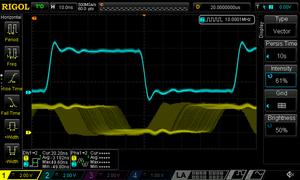- A new 4-channel scope
- A GPS-referenced tunable frequency generator
- A "PLJ-8LED-C" frequency counter from ebay
- An "AD9850 DDS freqency synthesizer breakout" from ebay
- A 10MHz OCXO from ebay years ago and miraculously rediscovered midway down a junk pile this weekend
Nothing earth shattering or super fancy, but it is still pretty amazing to be able to heat or cool the AD9850's (non-compensated) XO and see the digital frequency meter change. And it was gratifying to find that the OCXO can be tuned quite easily to 10,000,000MHz.
The PLJ frequency counter is adequate to its task. Supposedly it has a VC-TCXO, and while it has just a single turn adjustment for frequency, I was able to get it to consistently read 10,000,000MHz from OCXO and from GPS; the next day, it had drifted down to 9,999,999. Still, that's down in the .1ppm and is probably to be expexcted.
I found that when tuning the OCXO, it was much more useful to use the scope to visualize the changing relative phases of the two signals, than to use this particular frequency meter which needs a 1s gate time to measure a 10MHz signal at a precision of 1Hz, and can't do anything more precise than that.
To tune the OCXO, I set the GPS-referenced RF generator to 10MHz and hooked both up to the scope. With a time base of 100ns and a persistence of 10s, it's not only easy to fine tune the circuit, but a hand-wave estimate of the error by looking at the persisted signal. If it's 1 div wide, then the relative error between the two frequencies is 100ns/10s = 10ppb = 10 milliHz @ 10MHz.
The scope has a 1kHz signal for probe compensation and it also includes the signal generator option. To my surprise, the frequency error of the probe compensation was MUCH smaller than the frequency error of the signal generator!
Entry first conceived on 15 July 2018, 15:59 UTC, last modified on 16 July 2018, 22:54 UTC
Website Copyright © 2004-2024 Jeff Epler

